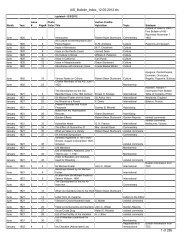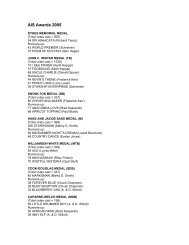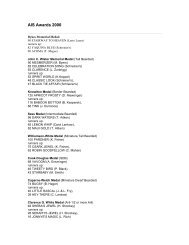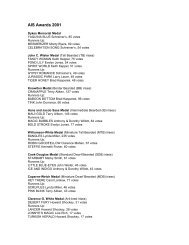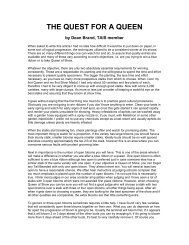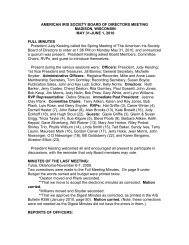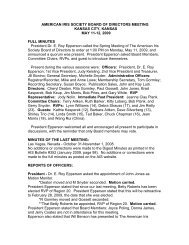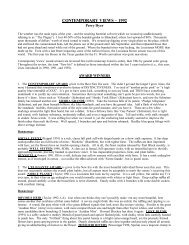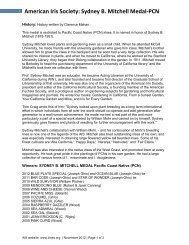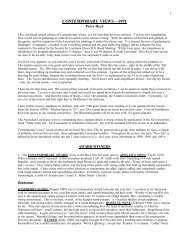contemporary views – 1988 award winners - American Iris Society
contemporary views – 1988 award winners - American Iris Society
contemporary views – 1988 award winners - American Iris Society
Create successful ePaper yourself
Turn your PDF publications into a flip-book with our unique Google optimized e-Paper software.
the garden. “Carrying power” is an understatement. And, again this year, BRANDY (McWhirter 1981), a wide, unique<br />
coloration of champagne to brandy tones with just the right amount of ruffling and lace to complement its broad form.<br />
7. The PICK OF THE LITTER AWARD goes to the most outstanding seedling viewed this year. For 1989 we have a<br />
dual winner: ANN BLOCHER (Blocher 1990), which also won the L’Elegante Award. About the only other thing about<br />
it I can say is that you will be able to purchase it next year through Roger Nelson at his new garden in Oregon.<br />
Runnersup:<br />
Marvin Granger 82-6 is an imposing Louisiana <strong>–</strong> with flowers perhaps even larger than ‘Elusive Butterfly’ (Ghio), but<br />
done in soft, feminine colors of lilac-lavender with hints of pink. The upper part of the falls has an attractive diffused cream<br />
sunburst ray pattern spraying out from the unobtrusive light yellow signal. The stalks are tall and strong with 5 well<br />
spaced bud positions, with the branches’ buds placed away from the stalk enough to ensure proper opening. The whole<br />
flower is then polished off with moderate ruffling and even a lot of lace and crimping. To be released in 1991 through<br />
Albert (Bobo) Faggard of Beaumont, Texas. [NOTE: It was named DEIRDRE KAY]. And Paul Black 85254AA,a TB<br />
that won Best Seeding at the Sooner State show this year, against tough competition. From an unusual cross of ‘Divine<br />
Guidance’ (Roderick) X ‘Miss Personality’ (Sexton), it is basically a ‘Fuji’s Mantle’ type amoena. White standards have<br />
just a blush of lavender. The falls are also white, but heavily saturated on the edges with medium lavender, going so far<br />
into the heart of the falls that it almost creates a “zonal” effect. A very tasteful color combination. To be released in 1990.<br />
[NOTE: It was named SIGHS AND WHISPERS].<br />
REDS TO MAROONS:<br />
TALL BEARDEDS BY COLOR GROUP<br />
WARRIOR KING (Schreiner 1985) continues to dominate this category. There is no way even the most imaginative<br />
hybridizer could have envisioned such quality even 20 years ago. This clear, sunfast garnet to cherry red has consistency in<br />
branching, bud count, and vigor never before seen in reds. That it blooms earlier in the season than many of the others is<br />
an important asset. CLEARFIRE (Stevens 1981) continues to impress with its bud count and vibrant of color. The<br />
stalks aren’t quite a strong as ‘Warrior King’ nor are the branches presented on the stalk as well, but is still worthy, and<br />
outperforms its contemporaries (except for ‘Warrior King’). The successor, if it continues with its performance, will be<br />
HEAT PUMP (Stevens 1986), a wider formed, brighter, even more glossy red. The branching perhaps even rivals<br />
‘Warrior King’. MARAUDER (Ghio 1984) is different, in that it is more of the wine red, but contrasted with most<br />
attractive bright gold beards. Proving to be a fascinating parent, too. Please note that, in each of these varieties, the vigor<br />
once missing in this color range is now present. This advancement is most noticeable in the garden. Gone are the days<br />
when we had to “endure” finicky growers such as ‘War Lord’ (Schreiner) or ‘Pride of Oklahoma’ (Dyer)!<br />
CLASSICS: DEEP FIRE (Schreiner 1979); CHIEF WAUKESHA (Blodgett 1978); TAMPICO (Luihn 1978).<br />
APRICOTS TO ORANGES:<br />
VICTORIAN FRILLS (Black <strong>1988</strong>) leads the apricots, and has been reviewed under the L’Elegante Award. ELEGANT<br />
ANSWER (Hager 1987) is a deeply ruffled and fluted peach with even broader form and stronger stalks than its parent,<br />
‘Beverly Sills’ (Hager). Exceptional, healthy plants. GOOD SHOW (Hager <strong>1988</strong>) is probably overall the best of several<br />
fine new oranges that hit the market at the same time. Large, broad, clear medium orange flowers are well held on strong,<br />
thick, well-balanced stalks that take inclement weather well. That the stalks don’t come crashing down, or worse yet,<br />
snake along the ground, is a marked improvement in this color class! FUN FEST (O. Brown <strong>1988</strong>), on a first-year plant<br />
in Blanchard, looked different from what I remembered in Opal’s garden after the 1984 Seattle convention. But then, by<br />
the time I got to Opal’s, my poor mind was pretty well numbed out from seeing so many irises! ‘Fun Fest’ is a lateblooming<br />
(of course!) light to medium apricot, slightly deeper at the shoulders, which surround an even deeper apricotorange<br />
beard. The waxy substance was appealing, and an important asset for a late blooming variety. CORAL COAST<br />
(Vizvarie 1989) has solid medium coral standards, topping chalky white falls (this is a new one on me!), then gently<br />
banded the standards’ coral color. The band is really more like a halo, and the substance matches the chalky look of the<br />
falls. Most impressive.<br />
CLASSICS: TANGERINE QUEEN (Marsh 1977); FRESNO CALYPSO (Weiler 1978); MARMALADE (Keppel<br />
1979).<br />
18



